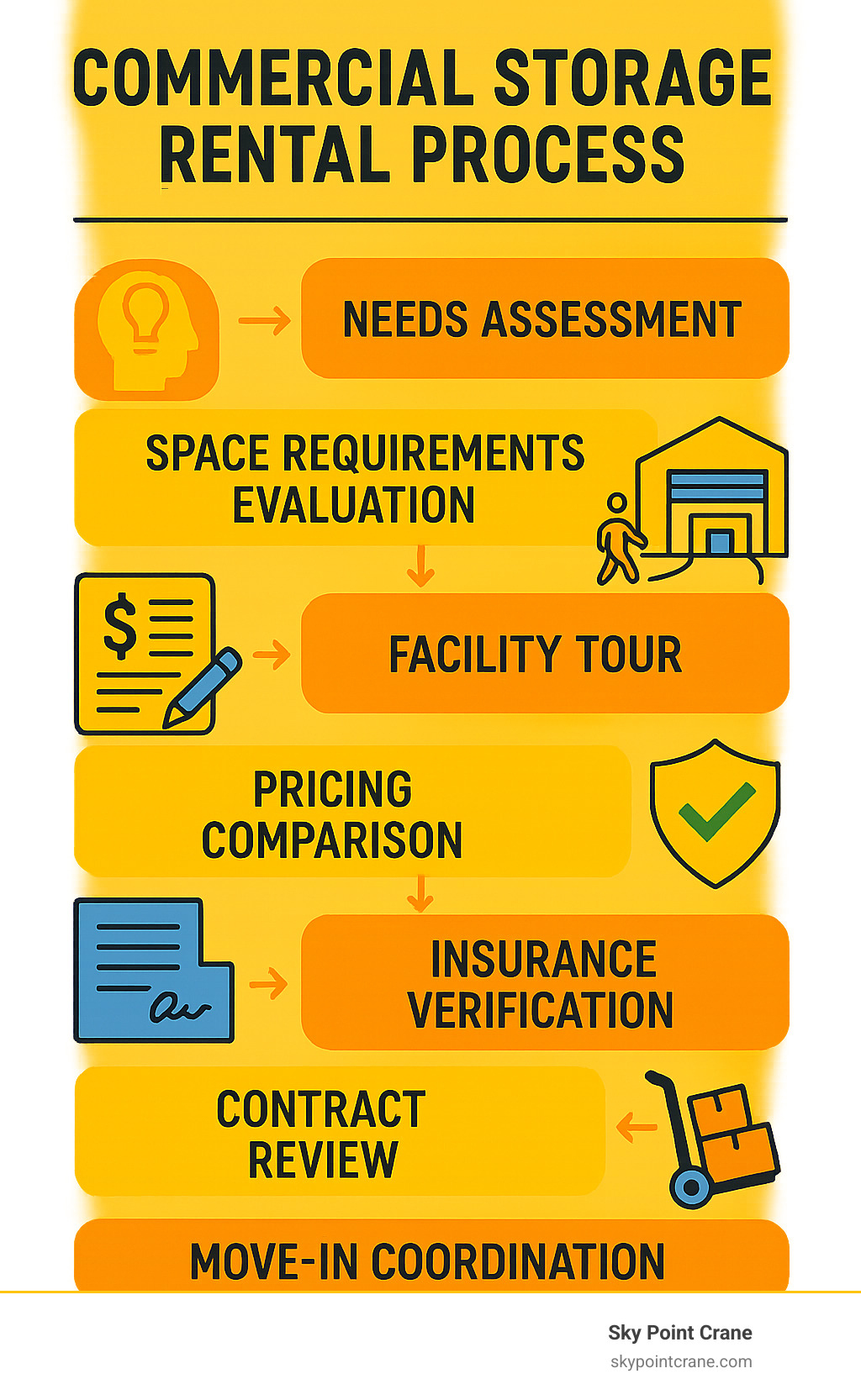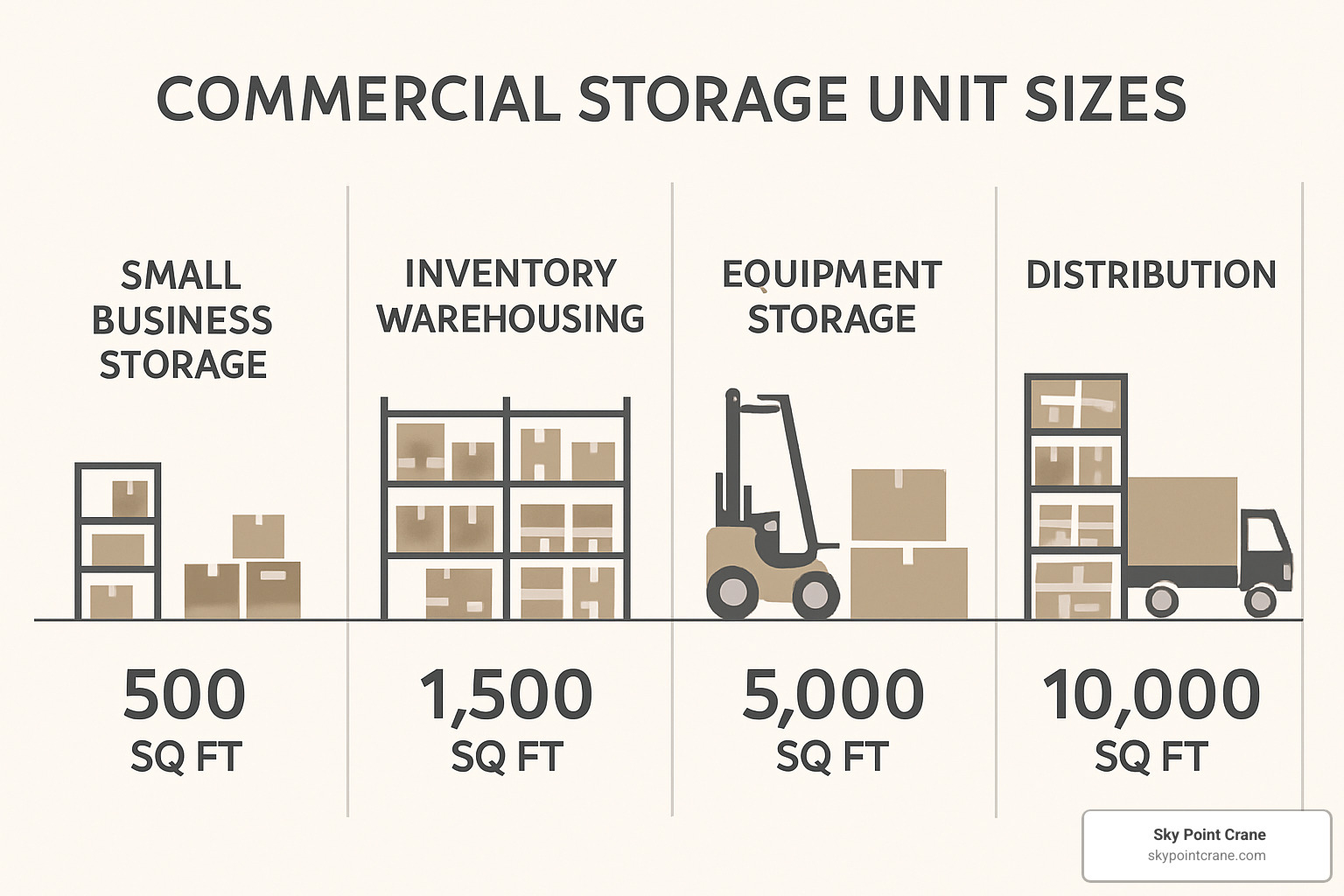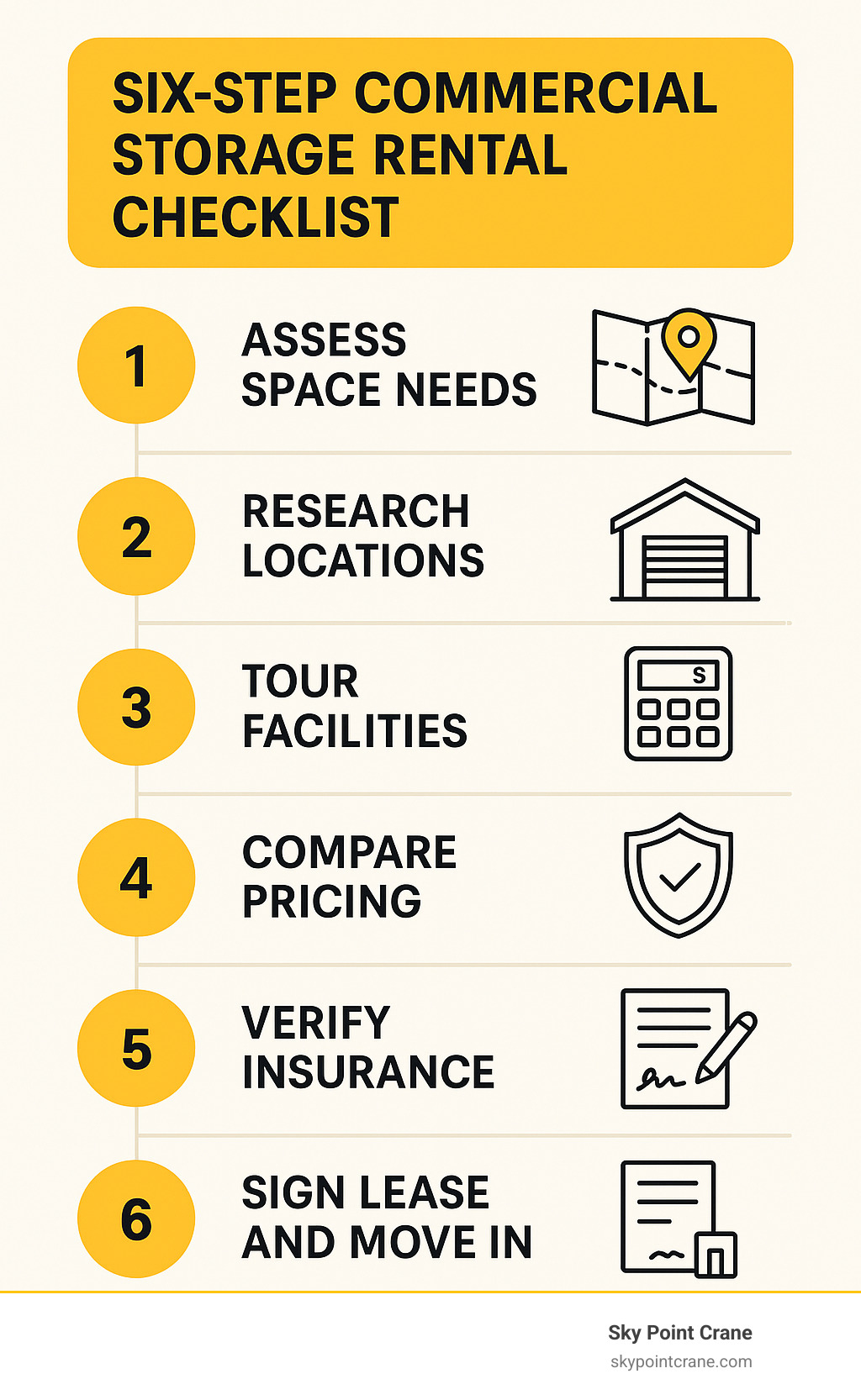Why Commercial Storage Buildings for Rent Are Essential for Growing Businesses
Commercial storage buildings for rent offer businesses flexible, cost-effective space solutions without the long-term commitment of purchasing property. These facilities provide significantly more space and business-friendly features compared to traditional self-storage units.
Key Benefits of Commercial Storage Building Rentals:
– Flexible lease terms – Month-to-month or short-term options (as little as 90 days)
– Business-grade amenities – Loading docks, drive-up access, climate control, 24/7 security
– Scalable space – Units range from 250 sq ft to over 100,000 sq ft
– Cost savings – Average $9 per square foot vs. traditional commercial real estate
– No long-term commitment – Easy to upgrade, downsize, or relocate as needs change
Whether you’re a contractor needing equipment storage, an e-commerce business managing inventory, or a manufacturer requiring distribution space, commercial storage rentals eliminate the overhead and inflexibility of traditional warehouse leases.
The rental process is straightforward – most facilities offer online reservations, transparent pricing, and quick move-in timelines. Many include essential business services like delivery acceptance, on-site equipment rentals, and office space integration.
As someone with over 30 years of experience in strategy development across multiple industries, I’ve seen how commercial storage buildings for rent can accelerate business growth while reducing operational headaches. The right storage solution creates operational flexibility that lets businesses focus on what they do best.

Simple commercial storage buildings for rent glossary:
– business storage for rent
– commercial storage facilities
– commercial storage facilities for sale
Understanding Commercial Storage Buildings for Rent
When I first started working with businesses across Pennsylvania, Ohio, West Virginia, and Maryland, I noticed a common challenge: companies needed more than just storage space. They needed commercial storage buildings for rent that could actually support their operations.
Commercial storage buildings for rent are built with business in mind from the ground up. Unlike standard storage units, these facilities are designed for companies that need to receive deliveries, move inventory, and sometimes run parts of their business right from the storage space.
Today’s facilities offer everything from co-warehousing arrangements where multiple businesses share resources, to flex-industrial spaces that can adapt as your needs change. Some even allow light manufacturing – imagine being able to assemble products in the same space where you store materials.
What really sets these facilities apart is how they handle compliance and industry-specific needs. A pharmaceutical rep storing temperature-sensitive samples has completely different requirements than a contractor storing heavy equipment.
How commercial storage buildings for rent differ from self-storage
The difference between commercial storage and regular self-storage is like comparing a pickup truck to a bicycle – they might both get you there, but one is clearly built for heavier work.
Loading infrastructure makes the biggest difference in day-to-day operations. Commercial storage buildings for rent come with proper loading docks, oversized roll-up doors that can handle delivery trucks, and wide aisles designed for forklifts and pallet jacks.
The scale is completely different too. While most self-storage units top out around 300 square feet, commercial units start at 250 square feet and can go up to 100,000 square feet or more. The sweet spot for many businesses is between 1,500-5,000 square feet, with ceiling heights of 18-22 feet.
Zoning regulations create another major distinction. Commercial storage facilities operate under industrial or commercial zoning that actually permits business activities. This means you can receive shipments, process orders, do light assembly work, or even run a small distribution center right from your unit.
The business support services at commercial facilities often surprise first-time renters. Many offer business centers with Wi-Fi, conference rooms, delivery acceptance, and equipment rentals.
Most common industries using commercial storage buildings for rent
E-commerce and retail businesses probably make up the largest group we see. Online retailers love having a space where they can receive inventory, store products, process orders, and ship directly to customers – all from the same location.
Construction and contractors are natural fits for commercial storage. These businesses need secure places to store expensive equipment, stage materials for upcoming jobs, and park work vehicles overnight.
Pharmaceutical sales representatives use climate-controlled units to protect sensitive samples and marketing materials. The professional environment and reliable delivery services support their sales operations.
Light manufacturing has become increasingly common as facilities adapt their rules and infrastructure. Small manufacturers can now do assembly work, quality control, and packaging without committing to traditional warehouse leases.
Retail overflow storage helps brick-and-mortar stores manage seasonal inventory, promotional materials, and excess stock.
Key Features & Amenities Businesses Should Demand
Finding the right commercial storage buildings for rent means looking beyond square footage to identify facilities that truly support your business operations.
Security should be your top priority. Professional facilities provide electronic gate access, 24-hour digital video surveillance, and individually alarmed units. The best facilities go further with CCTV monitoring and controlled access systems that track who enters and leaves your unit.
Climate control systems maintain consistent temperature and humidity levels throughout the year. If you’re storing pharmaceutical samples, electronics, paper documents, textiles, or food products, this feature isn’t optional.
Around-the-clock access separates commercial facilities from basic storage options. When your delivery truck shows up at 6 AM or you need emergency equipment access on a Sunday, 24/7 availability keeps your business running smoothly.
The loading infrastructure makes all the difference in daily operations. Look for covered loading bays, roll-up doors sized for delivery trucks, and drive-up access for quick transfers. These features protect your goods from weather and streamline your logistics operations.
Power and connectivity enable modern business operations directly from your storage unit. Electrical outlets throughout the space support equipment operation, lighting, and charging systems. Wi-Fi connectivity lets you run inventory management systems and handle business communications.
Many facilities now provide equipment like forklifts, pallet jacks, and hand trucks for tenant use. This eliminates the expense and hassle of purchasing or renting equipment separately.
Office integration has become increasingly popular, with some facilities offering loft spaces or separate office areas within warehouse units. These spaces support administrative functions and client meetings without requiring a separate office lease.
Delivery and mail services provide secure package storage until pickup, which is essential for businesses receiving frequent shipments or operating with limited staffing.
For more detailed information about commercial storage amenities, visit our Commercial Storage Facilities resource page.
Sizing, Pricing & Lease Structures Demystified
Figuring out the costs and sizing for commercial storage buildings for rent is actually pretty straightforward once you understand the basics.
Unit sizes in commercial storage facilities range dramatically, from compact 250 square foot spaces perfect for a contractor’s tools to massive 100,000+ square foot warehouses. Most growing businesses find their sweet spot somewhere between 750 and 5,000 square feet.
Ceiling height matters just as much as floor space. While smaller units might have 12-foot ceilings, larger spaces often feature 18 to 22-foot heights. This vertical space is valuable when you’re planning racking systems or storing tall equipment.
Capacity planning gets interesting when you think in pallets instead of just square footage. A typical 1,000 square foot unit can hold anywhere from 15 to 25 pallets, depending on your arrangement and aisle space needs.
The lease structures in commercial storage are refreshingly flexible compared to traditional warehouse deals. Most facilities offer month-to-month arrangements, which means you’re not locked into a five-year commitment.
Pricing models vary, but you’re typically looking at around $9 per square foot annually in our service areas. What makes commercial storage attractive is that most facilities bundle utilities, basic maintenance, and amenities into one price.
| Factor | Renting Commercial Storage | Buying Warehouse Space |
|---|---|---|
| Initial Investment | First month + deposit | Down payment + closing costs |
| Monthly Costs | $750-$7,500 (1,000-10,000 SF) | Mortgage + taxes + insurance + maintenance |
| Flexibility | Month-to-month options | Long-term commitment |
| Maintenance | Included in rent | Owner responsibility |
| Utilities | Often included | Separate billing |
| Scalability | Easy to resize | Requires selling/buying |
For current market data and available properties, check listings on LoopNet.

Calculating costs for commercial storage buildings for rent
The real cost calculation goes beyond just the square footage rate.
Base rental rates fluctuate based on location. In our Pennsylvania and Ohio markets, you’re typically looking at $6 to $12 per square foot annually. Units near major highways or transportation hubs cost more, but they can save you money on logistics and delivery times.
Utility considerations are where things get interesting. Many commercial storage facilities roll basic utilities into your rent, which simplifies budgeting. Climate-controlled units typically run 20 to 30% higher than standard storage.
Insurance requirements are non-negotiable at most facilities. You’ll need liability coverage and property protection for your stored goods. Commercial policies typically run $500 to $2,000 annually.
Determining the right unit size
Getting the size right the first time saves you headaches and moving costs later.
Inventory forecasting starts with understanding your current stock levels, including seasonal spikes. Add a 20 to 30% buffer for growth and operational flexibility.
Growth buffer planning is where most businesses trip up by being too conservative. Plan for 12 to 18 months of growth when selecting your initial space.
Racking and layout optimization can make or break your space efficiency. Good vertical storage systems can double or even triple your capacity compared to just stacking boxes on the floor.
Location Selection & Rental Process Workflow
Finding the perfect spot for your commercial storage buildings for rent can make or break your business operations. Location isn’t just about finding space – it’s about finding the right space that makes your daily operations smoother and more profitable.
Transportation access should be your first consideration. You want to be close enough to major highways that your delivery trucks aren’t burning extra fuel or time navigating back roads. In our service areas across Pennsylvania, Ohio, West Virginia, and Maryland, businesses thrive when they’re within a few miles of Interstate access.
The local labor market matters more than most business owners realize. If your storage operations require part-time help for loading, inventory management, or seasonal rushes, you’ll want to be in an area where you can find reliable workers.
Zoning compliance can trip up even experienced business owners. Not all commercial storage facilities allow the same activities, and local zoning laws add another layer of complexity. Some locations permit light assembly work, while others restrict you to pure storage.
When you’re ready for site tours, bring a checklist and your measuring tape. Check that loading docks can handle your largest delivery trucks. Walk the aisles with your equipment dimensions in mind. Look up at the ceiling height and imagine your storage systems in place.
Insurance coordination often gets overlooked until the last minute, but it’s crucial to get right. Your business insurance needs to cover activities at the storage location, and some policies require advance notification for off-site operations.
The lease signing process for commercial storage is refreshingly straightforward compared to traditional warehouse deals. Most facilities offer month-to-month terms with simple agreements, but you still want to read the fine print.
For location-specific options in our service areas, visit our Commercial Storage Buildings for Rent Near Me resource.

Legal & operational restrictions inside commercial storage buildings for rent
Even though commercial storage buildings for rent offer much more flexibility than traditional self-storage, you still need to understand what you can and can’t do.
Prohibited activities vary by facility, but some rules are nearly universal. Most places won’t let you set up retail storefronts with walk-in customers, prepare food commercially, or store hazardous materials. Heavy manufacturing is usually off-limits, though light assembly work often gets approval.
Fire code compliance isn’t just about following rules – it’s about protecting your business and everyone else in the facility. Keep aisles clear for emergency access, don’t block sprinkler heads, and maintain proper exit routes.
The business address question catches many new tenants off guard. You typically can’t use your storage unit as your official business address for licensing or legal mail delivery.
Operating hours might seem unlimited at 24/7 facilities, but common courtesy and local noise ordinances still apply. Most facilities ask tenants to keep noisy activities to reasonable business hours.
Maximizing Value & Ensuring Future Growth
Getting maximum value from commercial storage buildings for rent requires strategic planning, efficient systems, and proactive management approaches that support both current operations and future expansion.
Racking System Optimization: Professional storage systems can double or triple capacity compared to floor storage. Selective pallet racking, drive-in systems, or push-back racks accommodate different inventory types and access patterns.
Inventory Management Technology: Modern warehouse management systems (WMS) track inventory locations, monitor stock levels, and optimize picking routes even in smaller storage operations. Barcode scanning and mobile apps streamline operations and reduce errors.
Safety Protocol Implementation: Establish clear safety procedures for equipment operation, material handling, and emergency situations. Regular safety training reduces accidents, insurance claims, and liability exposure.
Periodic Operational Audits: Quarterly reviews of space utilization, inventory turnover, and operational efficiency identify improvement opportunities. Track metrics like cost per square foot and inventory turns to optimize performance.
Flexible Lease Management: Most commercial storage facilities allow easy upgrades or downsizes with minimal notice. Plan space adjustments around seasonal patterns, growth projections, or operational changes.
For specialized storage solutions, explore our Indoor Industrial Storage options.
Leveraging commercial storage buildings for rent as growth accelerators
Smart businesses use commercial storage strategically to accelerate growth, test new markets, and build operational flexibility that supports rapid scaling.
Seasonal Scaling Solutions: Retail and e-commerce businesses can expand storage capacity during peak seasons without long-term commitments. The ability to add 5,000-10,000 square feet for holiday inventory and release it in January provides tremendous operational flexibility.
Regional Distribution Nodes: Businesses expanding into new geographic markets can establish distribution points without major capital investments. A 2,000 square foot storage unit in a new market area can serve as a regional hub, reducing shipping costs while testing market demand.
Light Assembly and Manufacturing Zones: Many commercial storage facilities now permit assembly operations, allowing manufacturers to establish satellite production facilities. This approach enables businesses to serve regional markets and test new product lines without major facility investments.
Operational Flexibility: The month-to-month lease structure allows businesses to pivot quickly based on market conditions, seasonal demands, or growth opportunities.
Frequently Asked Questions about Commercial Storage Buildings for Rent
Let me address the most common questions we hear from businesses considering commercial storage buildings for rent.
What insurance or liability coverage is required?
Insurance requirements for commercial storage are actually pretty straightforward once you understand the basics.
General liability insurance is your main requirement – most facilities want at least $1 million per occurrence. This protects both you and the facility if someone gets hurt or property gets damaged during your operations. The facility will typically ask to be named as an additional insured party on your policy.
You’ll also need property insurance covering your stored goods. The cost usually runs between $500-$2,000 annually, depending on what you’re storing and what business activities you’re conducting in the unit.
Some facilities offer their own tenant insurance programs, which can be convenient. However, I’d recommend talking with your regular insurance agent first. They often provide better coverage at competitive rates and can make sure your policy properly covers off-site business operations.
The key is making sure your coverage includes business activities conducted at the storage location. Standard business policies sometimes need endorsements for off-site operations.
Can I run day-to-day business operations from my unit?
This is where commercial storage buildings for rent really shine compared to regular self-storage. Yes, you can absolutely run business operations from your unit – that’s the whole point of commercial-grade facilities.
Most facilities welcome activities like inventory management, order fulfillment, light assembly work, and distribution operations. We’ve seen contractors use units for equipment staging, e-commerce businesses running entire fulfillment operations, and manufacturers doing assembly work.
However, there are some reasonable limitations. You typically can’t do retail sales to walk-in customers – these facilities aren’t zoned for retail operations. Food preparation is usually prohibited for health code reasons, and heavy manufacturing with loud machinery often isn’t allowed due to noise restrictions.
One important legal detail: you cannot use your storage unit as your official business address for licensing, incorporation, or legal purposes. You’ll need to maintain a separate business address while using the storage facility for operations.
How quickly can I scale up or down my storage footprint?
The flexibility of commercial storage is honestly one of its biggest advantages, especially for growing businesses that need to adapt quickly.
Scaling up usually depends on availability, but most facilities keep waiting lists for popular unit sizes. If you’re a good tenant who pays on time, facility managers often give you first dibs on larger units when they become available.
Scaling down is typically even easier since facilities always have demand for smaller units. Most require 30-day notice for downsizing, though some want 60 days for larger units.
This flexibility has been a game-changer for businesses dealing with seasonal fluctuations. Retailers can expand for holiday inventory and contract after the season ends. Construction companies can scale up during busy periods and reduce costs during slower months.
Conclusion
Finding the right commercial storage buildings for rent can transform how your business operates, giving you the space and flexibility you need without the massive commitment of buying property. These facilities have evolved into sophisticated business hubs that can genuinely accelerate your growth.
The numbers speak for themselves. At around $9 per square foot annually, commercial storage costs significantly less than traditional warehouse leases while offering month-to-month flexibility that traditional real estate simply can’t match. Whether you need 250 square feet for a growing e-commerce operation or 25,000 square feet for regional distribution, these facilities scale with your business.
What really sets commercial storage apart is the business-grade infrastructure – loading docks that actually fit delivery trucks, 24/7 access when you need to work late, and security systems that protect your valuable inventory.
Through our work at Sky Point Crane across Pennsylvania, Ohio, West Virginia, and Maryland, I’ve watched businesses use commercial storage as a strategic advantage. Contractors store equipment securely between jobs, e-commerce companies fulfill orders directly from their units, and manufacturers test new markets without massive facility investments.
The rental process itself has become refreshingly straightforward. Most facilities offer online reservations, transparent pricing, and quick move-in timelines. No more months of negotiations or complex lease structures.
The commercial storage industry keeps evolving too. Co-warehousing spaces, integrated office areas, and even light manufacturing capabilities are becoming standard offerings. These facilities are becoming true business ecosystems where companies can operate, grow, and collaborate.
If you’re considering commercial storage, start with your actual needs rather than what you think you can afford. Calculate your current inventory, add a growth buffer, and think about your operational workflow. The right facility will support all three while giving you room to adapt as your business changes.
The decision-making process doesn’t have to be overwhelming. Assess your space requirements, research locations near your customers or transportation hubs, tour facilities to see what feels right, and compare not just pricing but the full package of amenities and services. Most importantly, verify that your insurance covers off-site operations before you sign anything.
At Sky Point Crane, we’ve seen how the right operational decisions can free businesses to focus on what they do best. Commercial storage buildings for rent offer that same kind of operational freedom, eliminating real estate headaches while providing the infrastructure modern businesses need to thrive.
For additional information about comprehensive industrial storage solutions, visit our Industrial Storage resource page.

